Top 10 IoT Specific Trends from CES 2020: The Smart Home Becomes The Intelligent Home
January 30th, 2020
Undoubtedly the world’s largest consumer electronics show, CES is a great indicator of where the IoT market is heading and what we can expect to see in the coming 2-3 years. Out of about 4500 exhibitors at CES 2020, more than 1000 companies were “internet of things” related, including smart home and city solution providers, wearables vendors, sensors, biometrics, and vehicle automation firms. The DSR team attended the show, and we are excited to share some of our impressions.
1. IoT Will Stand For “Intelligence of Things”
[caption id="attachment_713" align="aligncenter" width="300"]
![]() Venus Mirror by ICON.AI[/caption]
Venus Mirror by ICON.AI[/caption]
The IoT universe is constantly expanding and new types of devices are connecting to the internet. At CES 2020, a smart frying pan was announced. SmartyPans are equipped with weight and temperature sensors and can record recipes as you cook (https://smartypans.io/). An Interactive smart makeup mirror, ICON.AI, is able to diagnose skin diseases, helps to choose makeup, and supports Amazon Alexa (http://icon.ai/). However, the most intelligent device for smart home ecosystem was presented by Samsung. It’s called Ballie and is described as a “life companion”, not just ordinary smart assistant (see video below).
A Rolling ball-shaped robot, unlike Apple’s Siri or the Amazon Echo, doesn’t wait for a voice command, instead, it constantly monitors your actions, behavior, and activities. Ballie is proactive. For example, it can wait and take a photo when the lightning is favorable, or give a command to the smart vacuum cleaner to clean up the dog’s mess without bothering its owner.
Google Assistant now supports a wider range of compatible smart devices and gives an option to turn them on and off on a timer. You can say: “Hey Google, run the coffee machine at 7 a.m.” Moreover, you can now connect compatible smart devices with just a few taps as well as use smart digital sticky notes across smart displays. Google also has enhanced the translation capabilities of Assistant. Now the AI-driven voice assistant is able to translate text from more than 40 languages.
Plume demonstrated a motion detection system which operates without sensors and cameras (https://www.plume.com/). Plume Motion AI analyzes Wi-Fi signal delays between compatible OpenSync nodes and Wi-Fi connected devices to identify moving objects. This AI also helps to eliminate the problem of false home alarms, such as the detection of pets.
[caption id="attachment_714" align="aligncenter" width="300"]
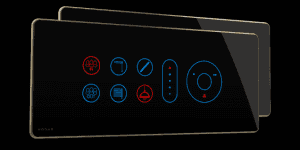 Prima Touch from Hogar Controls[/caption]
Prima Touch from Hogar Controls[/caption]
As demonstrated at CES 2020, multi-functional smart switches and displays are going to be one of the top home automation market trends, in the coming years. One Example is the Prima Touch Switch from Hogar Controls(https://www.hogarcontrols.com/). Prima Touch allows the user to configure a set of touch-sensitive buttons to control different smart devices and switch between predefined scenes. It supports Z-Wave and Zigbee protocols. More advanced smart displays are able to stream video, help to monitor household energy consumption, and quickly adjust smart home settings for the current occupants’ needs.
CES 2020 has demonstrated that the smart home ecosystem and smart devices themselves are becoming more intelligent. Increased connectivity, along with AI-driven solutions, allow the smart home ecosystem to provide much more utility, without the user’s direct involvement.
2. Power Shift Towards Interoperability
According to Statista estimates (https://www.statista.com/statistics/471264/iot-number-of-connected-devices-worldwide/), there are more than 26 billion connected IoT devices. With this vast quantity, comes complexity. Each IoT solution offers its own IoT infrastructure, APIs, and data formats, which leads to interoperability issues. Several initiatives aimed at enhancing interoperability were announces at CES 2020.
Lots of manufacturers’ smart devices are compatible with the OCF 2.1 standard (https://openconnectivity.org/developer/specifications/). The new version of the standard was released in November by the Open Connectivity Foundation, which boasts more than 300 members (Cisco, LG, Samsung, Intel etc.). OCF 2.1 provides detailed implementations for Bluetooth, EnOcean, Zigbee, and Z-Wave.
In December, Apple, Google, Amazon, the and Zigbee Alliance announced the creation of Connected Home over IP(https://www.connectedhomeip.com/). The goal is to create a working group for the development of a new open standard for smart home products, with a heavy focus on security.
Moreover, just over a month ago, Silicon Labs and the Z-Wave Alliance announced plans to open proprietary Z-Wave standard (https://z-wavealliance.org/z-wave-specification-press-release/). Before the announcement, Silicon Labs was the only manufacturer of MCUs with Z-Wave support. In the near future, other manufacturers will be able to produce Z-Wave chips. This is the first step to make the standard fully open.
DSR Corporation also contributed to this shift, as we announced the ZBOSS Open Initiative (ZOI) at CES 2020 (http://dsr-zoi.com/). This is a community of companies with a shared understanding of the necessity to have a common Zigbee PRO software platform to overcome, together, the shared challenges around interoperability, security, testing, and optimization of Zigbee-enabled products and solutions.
3. Wi-Fi 6 to boost smart home
Wi-Fi 6 (802.11ax) will increase the throughput and speed of IoT networks, decrease delays, and make smart homes more secured. Thanks to the support of OFDMA и BSS Coloring technologies, smart home and office solutions based on Wi-Fi 6 will manage network traffic more efficiently, especially in a radio dense environment.
WPA3 will significantly improve the security of IoT networks in comparison to WPA2 thanks to the Simultaneous Authentication of Equals (SAE) protocol, which is used in Wi-Fi 6, instead of Pre-Shared Keys (PSK). The new standard will make IoT networks a lot harder to hack.
What’s more, Wi-Fi 6 routers support up to 1024 connected devices simultaneously, whereas current Wi-Fi generation is able to support only 250. This is a great step forward for smart home and office automation, hence just one Wi-Fi 6 enabled router will be able to manage more than thousand smart devices.
[caption id="attachment_715" align="aligncenter" width="300"]
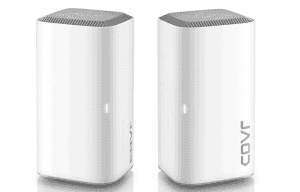 Two-piece router D-Link COVR X1872 supports Wi-Fi 6 and enables to setup mesh IoT networks[/caption]
Two-piece router D-Link COVR X1872 supports Wi-Fi 6 and enables to setup mesh IoT networks[/caption]
Quite a number of manufacturers announced routers with Wi-Fi 6 support, including D-Link, TP-Link, Linksys, and Netgear. Comcast also revealed the xFi Advanced, an IEEE 802.11ax certified gateway.
4. 5G – the first generation of cellular networks for IoT
According to an Ericsson forecast (https://www.ericsson.com/en/mobility-report/internet-of-things-forecast), over 1.5 billion IoT devices will be connected to cellular networks by 2022. 5G is the first generation of mobile networks designed with IoT industry requirements in mind. Apart from a tenfold speed increase (up to 15-20 Gbit/s) in comparison to 4G, 5G supports 250 times more connected devices — over 1 million devices per 1 square kilometer. The capacity of 4G is limited to a mere 4,000 devices per square kilometer. CTA forecasts that more than 50 mobile network operators throughout the world will launch 5G in 2020 (https://cta.tech/).
[caption id="attachment_716" align="aligncenter" width="300"]
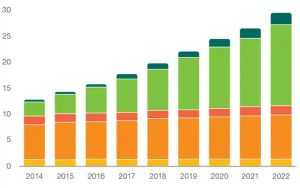 _Connected devices (billions). Source: https://www.ericsson.com/_\[/caption\]
_Connected devices (billions). Source: https://www.ericsson.com/_\[/caption\]
For the IoT market, the 5G network deployment means the increased use and efficiency of cloud services, significantly lower latency (down to 1 ms), and greatly increased throughput. All of these improvements will allow for the creation of a robust smart city infrastructure, an industrial IoT solution with hundreds of thousands of smart sensors and devices.
Significantly lower latency in 5G networks will allow for the control of automated vehicles and industrial machinery, remotely, from another part of the world. 5G can also can be used by farmers to oversee massive areas of land with the help of a drone fleet equipped with a variety of sensors. Drones can identify diseased plants or areas than need to be watered. It’s a great example of how 5G based IoT systems will help to solve very real-world problems.
5. Biometrics for smart home and office
[caption id="attachment_717" align="aligncenter" width="300"]
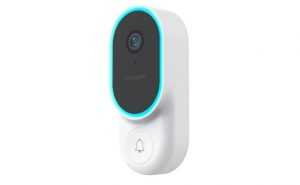 Blurams Smart Doorbell with face recognition technology[/caption]
Blurams Smart Doorbell with face recognition technology[/caption]
Face recognition technology is making its way into the smart market. More and more devices are capable of using face recognition for access. Blurams revealed a smart doorbell at CES (https://www.blurams.com/). The doorbell sports AI facial recognition, a 1080p camera, motion detection, and 2-way talk function including hands-free calling. Faces are identified in real-time, with all of the data stored in company’s cloud storage. Blurams’s app allows users to register up to 16 people for identification.
ADT presented a range of smart cameras (https://www.adt.com/). Sophisticated computer vision technology helps to not only identify authorized users, but also distinguish between strangers and burglars. The smart camera system will notify its owner about suspicious strangers around the house via push notifications in the app and voice messages via Amazon Alexa. Cameras are equipped with a microphone and speaker for voice communication, as well as a light sensor.
Additionally, several companies at CES 2020 revealed smart door locks equipped with fingerprint scanners.
6. Wireless Charging for Smart Devices
A few companies announced wireless chargers for smart home devices at CES 2020.
[caption id="attachment_718" align="aligncenter" width="300"]
 Wi-Charge Powerpuck R1 wireless charger[/caption]
Wi-Charge Powerpuck R1 wireless charger[/caption]
Wi-Charge revealed the Powerpuck R1 charger with AirCord infrared beam technology (https://wi-charge.com/). It can be plugged into a wall or screwed into a lightbulb socket. The charger is able to charge compatible smart devices from a distance of up to 9 meters, covering almost 2.5 square meters. The receivers measure just 1x1 cm and can be embedded in the charged devices. R1 initiates the charging of compatible devices right after the installation without any additional configuration.
[caption id="attachment_719" align="aligncenter" width="300"]
 Ossia’s Cota is able to charge smart devices via Wi-Fi like a radio[/caption]
Ossia’s Cota is able to charge smart devices via Wi-Fi like a radio[/caption]
Unlike the Powerpuck R1, Ossia’s wireless charger, Cota, doesn’t require direct line of sight to power smart devices (https://www.ossia.com/cota/),. Cota measures 30x30 cm and transmits power via 5.8 GHz radio signal. Just like Wi-Fi, but instead of data, the chargers send power to the connected devices.
[caption id="attachment_721" align="aligncenter" width="300"]
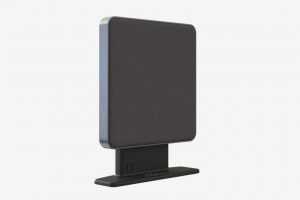 Ossia's Cota Home Transmitter[/caption]
Ossia's Cota Home Transmitter[/caption]
Receivers with Cota wireless charging support can be embedded in smart speakers, thermostats, cameras, smoke detectors, and other smart devices. The charger transmits power up to 9 meters, doesn’t require direct line of sight, and is able to charge notebooks, smartphones, remote controls, and other gadgets.
The variety of wireless chargers, demonstrated at CES 2020, will help to solve one of the main smart home ecosystem problems – battery changing and power limitations. However, the solutions currently have some drawbacks, like the need to embed a specific supported receiver in the end-devices and significant power loss during transmission.
7. Enhanced Voice Control
Voice assistants are used in smart home solutions more and more often, and their advancement will allow to for more sophisticated automation scenarios and features. So far, voice control is widely adopted in English-speaking countries, but thanks to significant improvements in speech recognition they’ll be used in other countries in 2020 as well. Juniper Research predicts that more than 8 billion smart devices will support voice commands by 2023 (https://www.juniperresearch.com/press/press-releases/digital-voice-assistants-in-use-to-8-million-2023).
[caption id="attachment_720" align="aligncenter" width="300"]
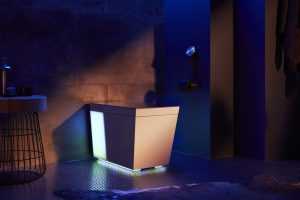 Kohler Numi 2.0 — an intelligent toilet with Amazon Alexa for easy voice control[/caption]
Kohler Numi 2.0 — an intelligent toilet with Amazon Alexa for easy voice control[/caption]
Voice assistants are supported by a wide range of smart devices including fridges, toilets, shower cabins, door locks, and garage gate openers. However, the most recent trend in IoT is not only voice, but sounds recognition. Audio Analytic, a startup at CES 2020, announced “the second generation” of audio recognition technology for smart devices based on its extensive Alexandria library (https://www.audioanalytic.com/). The library contains more than 15 million labelled sound samples. This technology enables smart devices to identify different sounds and act accordingly. For example, a security system with Alexandria support will be able to identify the sound of shattered window glass in the house and set-off the alarm to notify the owner about a possible break-in. Or, smart home will be able to “hear” child cry and notify parents, play soothing music for him or her, and turn on the lights in the corridor leading to the child’s room. Audio Analytic’s sound recognition technology uses AI and neural network to accurately identify different sounds. It’s already supported by some smart hubs on the market, including Hive Hub 360.
8. Smart home security and privacy are in the spotlight
CES 2020 showed that in the coming years more and more efforts will be devoted to making smart home systems and IoT devices significantly more secure. The Amazon Ring cameras hack last December sounded the alarm for manufacturers and service providers to pay a lot more attention to the security flaws of current IoT solutions. The number of hackers’ attacks on smart home and office systems will only increase since they are still easy targets.
To address the issue, Comcast revealed the free app, Xfinity xFi, for it’s smart ecosystem. The app monitors and controls traffic, blocks suspicious activities and notifies the user about abnormal data sent from end devices. Apple attended CES for the first time in 28 years to discuss users’ data privacy issues, while Google Assistant will now erase data if activated accidentally. One just needs to say “Hey Google, that wasn’t meant for you”. Moreover, users can open a new dashboard to see how the service uses recorded data, view privacy settings, and delete any record from the last 18 months.
Amazon also enabled the option to erase records for Alexa with the help of the phrases: “Alexa, delete what I just said” and “Alexa, delete everything I said today.”
9. Office Automation is the Next Big thing
2020 will be the year for wider office automation systems adoption even by mid-sized companies. The systems will help to make office workspace more comfortable, controllable, safe, and energy efficient.
Smart offices will be able to automatically adjust lightning and temperature depending on the weather outside, making the workspace not only more convenient for employees, but also less energy consuming. Smart doorbells, motion sensors, door locks, and cameras will help to identify strangers and grant employees access to the certain areas of the office.
Office automation will help to book meeting rooms more efficiently, control lighting, and manage other key routine activities.
[caption id="attachment_722" align="aligncenter" width="300"]
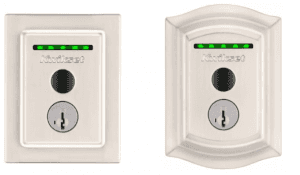 The Kwikset Halo Touch smart door lock with Wi-Fi support and fingerprints scanner (https://www.kwikset.com/halo-touch). [/caption]
The Kwikset Halo Touch smart door lock with Wi-Fi support and fingerprints scanner (https://www.kwikset.com/halo-touch). [/caption]
A great number of smart devices presented at CES 2020 will be used for office automation, starting with smart touch switches, all the way to wireless chargers for smart devices.
10. AI-Driven Smart Energy
A connected smart home not only makes smart device management a breeze, but also helps to reduce energy consumption. For example, there is no need to heat the house if there’s no one present. With the help of a connected thermostat and smartphone app, the owner of the house can create optimal scenarios or leave it to an AI-powered service which analyzes user’s habits and behavior patterns and can offer the most energy-efficient temperature control scenes without any impact on comfort. Lighting and other variables can also be controlled automatically in a similar way.
The use of AI makes smart home solutions more intelligent. Moreover, the geolocation capabilities of smartphones allow, for example, for the AI to prepare a certain scenario (temp, lights, coffee, music, etc.) when the user is commuting home.
DSR Corporation is participating in Wondrwall intelligent living project(http://en.dsr-corporation.com/news?id=630). Different temperature modes have already been implemented, and in the nearest future users will be able to connect solar panels and automatically buy and sell energy for the most competitive prices.